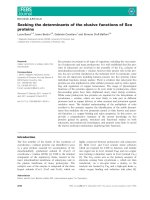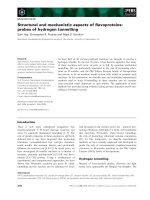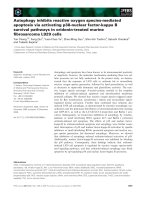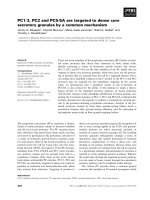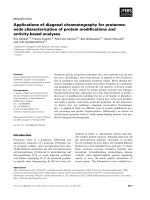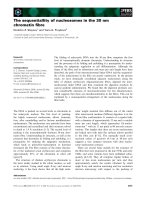Báo cáo khoa học: "Air or 100% oxygen for asphyxiated babies? Time to decide" pptx
Bạn đang xem bản rút gọn của tài liệu. Xem và tải ngay bản đầy đủ của tài liệu tại đây (39.22 KB, 3 trang )
128
OFR = oxygen free radical.
Critical Care April 2005 Vol 9 No 2 Robertson
Abstract
Both experimental and clinical studies have demonstrated that
room air is as efficient as 100% oxygen for newborn resuscitation
and improves short-term recovery. The recent meta-analysis by
Davis and colleagues in the Lancet includes five studies from the
past 10 years where asphyxiated infants were randomised or
pseudo-randomised to be resuscitated in room air or in 100%
oxygen. A significant reduction in mortality was seen when infants
were resuscitated in room air compared to 100% oxygen. It is
astonishing that a brief exposure of only a few minutes to 100%
oxygen may be so toxic to the newborn infant; this finding,
however, is supported by increasing evidence from experimental
work emphasising that resuscitation in 100% oxygen may be
associated with an aggravation of cellular injury when compared
with resuscitation in air. It is imperative that these findings are
reflected in the new newborn resuscitation guidelines and that
further research continues in this area of neonatal medicine. Key
areas include defining the best resuscitation practice for the
preterm infant, designing adequate multicentre, randomised and
blinded studies of term newborn resuscitation with adequate
outcome data, and pursuing intense experimental research into the
mechanisms and prevention of injury from oxygen free radicals.
Around 5–10% of all newborn infants born worldwide require
some degree of resuscitation at birth, ranging from simple
stimulation to assisted ventilation. Defining the optimum
technique for neonatal resuscitation is an extremely important
challenge and has the potential to improve neonatal outcome
globally. In the past two decades, neonatal research has
established that, if assisted ventilation is required, room air is
as efficient as 100% oxygen for newborn resuscitation. The
meta-analysis published in the Lancet [1] goes further and
suggests that mortality is lower in newborn infants
resuscitated in room air compared with those resuscitated in
100% oxygen. One death would be prevented for every 20
babies resuscitated with air versus 100% oxygen. Several
hundred thousand deaths might be prevented by avoiding
100% oxygen during resuscitation. It is astonishing that a
brief exposure of only a few minutes to 100% oxygen may be
so toxic to newborn infants. A brief review of the
experimental, basic science and clinical literature on this
subject adds weight to this finding. It is imperative that
newborn resuscitation guidelines are now revised.
The process of childbirth is accompanied by increased
oxidative stress, as birth itself is a hyperoxic challenge. The
foetus transfers from an intra-uterine hypoxic environment
with a pO
2
of 20–25 mmHg to an extra-uterine environment
with a pO
2
of 100 mmHg.
During the 20th century it became traditional to use 100%
oxygen to resuscitate infants in hospitals because labour
wards only had oxygen as a compressed gas [2,3]. It seemed
logical and intuitive to reverse the anaerobic state as quickly
as possible with 100% oxygen because 18–19 times more
ATP is produced from glucose during aerobic metabolism
than during anaerobic metabolism. Howere, following the
discovery of the link between retinopathy of prematurity and
the liberal use of supplemental oxygen therapy, controversy
has surrounded the use of oxygen in neonatology [4,5].
There was considerable interest in the 1930s in the ‘oxygen
paradox’ — the concept that tissue injury may be aggravated
when 100% oxygen is administered following a significant
period of hypoxia ischaemia. The link between oxygen and the
generation of oxygen free radicals (OFRs) was an immense
leap forward [6,7]. Following transient hypoxia ischaemia and
reperfusion/reoxygenation, OFRs are generated by the
xanthine oxidase system; their production is dependent on the
tissue concentration of oxygen, hypoxanthine and other
purines [8]. OFRs are cytotoxic because they have the ability
to interact with and alter the principal components of cells
including proteins, lipids, carbohydrates and DNA [9]. In
addition, OFRs play an important role in apoptosis and
necrosis [10]. Mammals have developed different mechanisms
of protection against OFRs such as scavengers, repair agents,
reduced glutathione, antioxidants and antioxidant enzymes
(glutathione eproxidase, catalase, superoxide dismutase). The
neonatal brain, in particular the preterm brain, is vulnerable to
oxidative damage due to its high concentrations of
Commentary
Air or 100% oxygen for asphyxiated babies? Time to decide
Nicola J Robertson
Senior Lecturer in Neonatology/Honorary Consultant Neonatologist, Department of Obstetrics and Gynaecology, University College London, UK
Corresponding author: Nicola Robertson,
Published online: 11 February 2005 Critical Care 2005, 9:128-130 (DOI 10.1186/cc3059)
This article is online at />© 2005 BioMed Central Ltd
129
Available online />unsaturated fatty acids, its low concentration of antioxidants
and the availability of redox-active iron [11].
Over the past 20 years the Norwegian group led by Ola
Saugstad used the newborn piglet model to compare the in
vivo effects of resuscitation with room air versus resuscitation
with oxygen. Restoration of basic biochemical and
physiological variables after hypoxia was shown to be as
quick with reoxygenation with room air as with 100% oxygen
[12]; furthermore, the production of OFRs was higher in
leukocytes in the 100% oxygen group. In 2001, piglets with
pneumothorax-induced asphyxia resuscitated in air were
shown to have better short-term neurological outcomes than
animals resuscitated in 100% oxygen [13]. Other studies
show apparent increased brain injury (measured by cerebral
leakage of glycerol) in conjunction with a reduced antioxidant
capacity in cerebral tissue in animals resuscitated in 100%
oxygen compared with those resuscitated in air [14].
The important findings to emerge from three clinical studies
are that room air is as effective as 100% oxygen for
resuscitation of the newborn [15–17] and may be superior to
100% oxygen in terms of both physiological and pathological
effects. A new and surprising finding was that the use of
100% oxygen delayed the time to first breath and cry
compared with the room air [15–17], and infants resuscitated
with room air required less time of ventilation to achieve a
regular respiratory pattern compared with those resuscitated
with 100% oxygen. In addition, resuscitation with 100%
oxygen had long-term effects on oxidative stress (oxidation of
blood glutathione) up to 4 weeks following birth, whereas
those resuscitated in air did not [17]. Oxidative stress may
also induce DNA damage; this could explain why an
association has been seen between delivery room oxygen
exposure and later childhood lymphatic leukaemia [18].
The recent systematic review and meta-analysis published in
the Lancet [1] combining data from five clinical trials
[15–17,19,20] that compared resuscitation with air versus
100% oxygen demands that we re-examine our current
practice and guidelines. Although no individual trial included
in this meta-analysis was adequately powered to show a
difference in mortality, the pooled analysis of 1302 infants
(randomised or pseudo-randomised) showed a significant
benefit for infants resuscitated with air (relative risk, 0.71;
95% confidence interval, 0.54–0.94). A second meta-
analysis involving the same five studies but with different
inclusion criteria found a similar reduction in neonatal
mortality with room air resuscitation, even in those with an
Apgar score < 4 at 1 min [21]. In their last consensus
statement published in 2000 [22], the American Academy of
Pediatrics along with the American Heart Foundation and the
International Liason Committee for Resuscitation
recommended the use of 100% oxygen during positive
pressure ventilation as “… data is insufficient to justify a
change …”. In the next year we are expecting new guidelines
from the International Liason Committee for Resuscitation — it
is time to change.
Many questions, however, remain unanswered.
What is the optimal concentration of oxygen for resuscitation
of asphyxiated infants? Is it the same for infants who are
mildly asphyxiated as for those who are severely asphyxiated?
Further trials are needed that stratify the severely asphyxiated
subgroup. If the main aim is to achieve normal levels of blood
oxygen throughout and beyond the resuscitation period,
routine use of the pulse oximeter in the labour ward will be
needed to tailor oxygen delivery to each infant.
Can the results of the meta-analyses be applied generally?
Most infants in the meta-analyses were recruited in
developing countries where antenatal and perinatal care,
resuscitation practices and perinatal mortality rates differ from
those in developed countries.
Do resuscitation practices make a difference to neuro-
developmental outcome — this has not been addressed and
will be difficult to address accurately as detailed follow-up is
required on a large scale. Future trials must include detailed
neurodevelopmental outcome scores at 18–24 months.
How should we resuscitate the preterm infant? The preterm
brain is likely to be even more vulnerable to the adverse
effects of hyperoxia compared with infants born at term due
to the extreme vulnerability of the pre-oligodendrocyte to
oxidative stress, the very low antioxidant levels in the preterm
brain and excess free iron due to the commonly associated
intraventricular haemorrhage. There is insufficient evidence at
present, however, to make any recommendations for
resuscitation of preterm infants.
To resolve these important questions, further clinical trials are
needed; it may not be ethical to include a comparison of air
versus 100% oxygen, and a midpoint such as 50% oxygen
may be required. Intense and detailed experimental studies
are also required to facilitate a clearer understanding of
mechanisms of damage. These studies must be correlated
with detailed brain histology.
It is more than 200 years since oxygen was discovered by the
English clergyman and amateur chemist, Joseph Priestly. At the
time Priestly warned against oxygen, saying: “… the air which
nature has provided us may be as good as we deserve”. The
recent meta-analyses [1,21], taken in the context of two
decades of translational research, strongly suggest that our
practice of resuscitating term infants who need positive
pressure ventilation in 100% oxygen should be avoided in most
cases. Room air appears to be safe. The discovery that mortality
is lower in asphyxiated infants resuscitated in room air is a
tremendous advance in neonatal medicine and newborn
resuscitation guidelines and practice need to be revised globally.
130
Critical Care April 2005 Vol 9 No 2 Robertson
Competing interests
The author(s) declare that they have no competing interests.
References
1. Davis PG, Tan A, O’Donnell CPF, Schulze A: Resuscitation of
newborn infants with 100% oxygen or air: a systematic review
and meta-analysis. Lancet 2004, 364:1329-1333.
2. Raju TNK: History of neonatal resuscitation. Tales of heroism
and desperation. Clin Perinatol 1999, 26:629-640.
3. Milner AD: Resuscitation at birth. Eur J Pediatr 1998, 157:524-527.
4. Campbell K: Intensive oxygen therapy as a possible cause of
retrolental fibroplasia: a clinical approach. Med J Aust 1951, 2:
48-50.
5. Silverman WA: A cautionary tale about supplementary oxygen:
the albatross of neonatal medicine. Pediatrics 2004, 113:394-396.
6. Latham F: The oxygen paradox. Experiments on the adverse
effects of oxygen in human anoxia. Lancet 1951, 1:77-81.
7. Gerschman R, Gilbert DL, Nye SW, Dwyer P, Fenn WO: Oxygen
poisoning and X-rays irradiation: a mechanism in common.
Science 1954, 119:624-626.
8. Fridovich I: Quantitative aspects of the production of superox-
ide anion radical by mild xanthine oxidase. J Biol Chem 1970,
245:4053-4057.
9. Saugstad OD: Free radical-mediated processes. In Birth
Asphyxia and the Brain. Edited by Don SM, Sinha S, Chiswick M.
New York: Futura Publishing Company; 2002:189-212.
10. Hockenbery DM, Oltvai ZN, Yin XM, Milliman CL, Korsmeyer SJ:
Bcl-2 functions in an antioxidant pathway to prevent apopto-
sis. Cell 1993, 75:241-251.
11. Ferriero DM: Neonatal brain injury. N Engl J Med 2004, 351:
1985-1995.
12. Roowelt T, Loberg EM, Moen A, Oyasaeter S, Saugstad OD:
Blood pressure, acid–base status, hypoxanthine concentra-
tions and brain morphology in hypoxic newborn pigs venti-
lated with either room air or 100% oxygen. Pediatr Res 1992,
32:107-113.
13. Temesvari P, Karg E, Bodi I: Impaired early neurologic outcome
in newborn piglets reoxygenated with 100% oxygen com-
pared with room air after pneumothorax-induced asphyxia.
Pediatr Res 2001, 49:812-819.
14. Munkeby BH, Borke WB, Bjornland K, Sikkeland LI, Borge GI,
Halvorsen B, Saugstad OD: Resuscitation with 100% O
2
increases cerebral injury in hypoxemic piglets. Pediatr Res
2004, 56:783-790.
15. Ramji S, Ahuja S, Thirupuram S, Rootwelt T, Rooth G, Saugstad
OD: Resuscitation of asphyxic newborn infants with room air
or 100% oxygen. Pediatr Res 1993, 34:809-812.
16. Saugstad OD, Rootwelt T, Aalen O: Resuscitation of asphyxi-
ated newborn infants with room air or oxygen: an international
controlled trial: the Resair 2 study. Pediatrics 1998, 102:e1-e7.
17. Vento M, Asensi M, Sastre J, Garcia-Sala F, Pallardo FV, Vina J:
Resuscitation with room air instead of 100% oxygen prevents
oxidative stress in moderately asphyxiated term neonates.
Pediatrics 2001, 107:642-647.
18. Naumburg E, Belloco R, Gnattingius S, Jonzon A, Ekbom A: Sup-
plementary oxygen and risk of childhood lymphatic
leukaemia. Acta Pediatr 2002, 91:1328-1333.
19. Vento M, Asensi M, Sastre J, Lloret A, Garcia-Sala F, Vina J:
Oxidative stress in asphyxiated term infants resuscitated with
100% oxygen. J Pediatr 2003, 142:240-246.
20. Ramji S, Rasaily R, Mishra PK, Narang A, Jayam S, Kapoor AN,
Kambo I, Mathur A, Saxena BN: Resuscitation of asphyxiated
newborns with room air or 100% oxygen at birth: a multicen-
tric clinical trial. Indian Pediatr 2003, 40:510-517.
21. Saugstad OD, Ramji S, Vento M: Resuscitation of depressed
newborn infants with ambient air or pure oxygen: a meta-
analysis. Biol Neonate 2004, 87:27-34.
22. Niermeyer S, Kattwinkel J, Van Reempts P, Nadkarni V, Phillips B,
Zideman D, Azzopardi D, Berg R, Boyle D, Boyle R, et al.:
International Guidelines for Neonatal Resuscitation: an
excerpt from the Guidelines 2000 for cardiopulmonary resus-
citation and emergency cardiovascular care: International
Consensus on Science. Contributors and reviewers for the
Neonatal Resuscitation Guidelines. Pediatrics 2000, 106:E29
[ />
